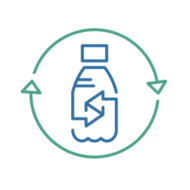The problem of plastic pollution in the environment is familiar to most of us these days. Litter, overflowing landfill sites, ocean gyres of floating garbage and beach pollution are hot topics.
But it’s not only a problem for the planet; did you know that plastic pollution can also be harmful to our own health?
HOW DO PLASTICS AFFECT HUMAN HEALTH?
There are two types of plastic-related chemicals that are of most concern for human health—bisphenol-A, and additives used in the synthesis of plastics, known as phthalates[i].
These plastic chemicals can be absorbed by the body. Plastics and their additives are inside virtually every one of us, present in blood and urine in measurable amounts.
Bisphenol-A – commonly known as BPA – is a basic constituent of polycarbonate plastics used to make a wide range of products such as water bottles, food packaging and other items.
BPA is an endocrine disrupter that mimics hormones in the body and can affect the developmental, neural and reproductive structures, especially in babies and young children.
Alongside other endocrine disruptors in plastics (such as BPB, BPC, BPS etc.), BPA is linked to increased risk of breast and prostate cancer, obesity, cardiovascular disease, cognitive developmental delay, metabolic disorders, reproductive dysfunction and decreased birthweight[ii].
Plastics also contain toxic additives such as colorings, flame retardants and plasticizers, which can leach out over time. Phthalates are used as plasticizers to manufacture vinyl flooring and wall coverings, food packaging and medical devices. Many of these toxic substances are present in the products we use daily, particularly those that haven’t undergone proper product testing and are not compliant with regulations, like Registration, Evaluation, Authorization, and Restriction of Chemicals (REACH) and Restriction of Hazardous Substances (RoHS).
Researchers have linked phthalates to a wide range of health problems including asthma, attention-deficit hyperactivity disorder, breast cancer, low IQ, neurodevelopmental issues, behavioral issues, autism spectrum disorders, altered reproductive development and male fertility issues[iii].
How do these chemicals enter the human body?
Plastics and associated chemical additives are ingested with the food we eat, the water we drink and from other sources.
You may be eating a variety of unpleasant chemicals depending on your diet. As well as the chemicals contained within plastic itself, when waste plastic particles float in the ocean, they attract and absorb heavy metal contamination and other pollutants[iv].
Fish and other marine animals consume plastics both intentionally and unintentionally. Once they absorb chemicals from ingested plastic, those chemicals are transferred up the food chain to anything that eats them, including humans. By eating contaminated fish and seafood, you may be consuming microplastics and chemicals you’d never knowingly choose to ingest.
Tap water is also widely contaminated by plastic. Recent studies found that 83% of the tap water samples from around the world were contaminated with plastic fibers[v].
The US had the highest contamination rate, at 94%, while Lebanon and India had the next highest rates. The lowest contamination rate was found in European countries including the UK, Germany and France, but this was still alarmingly high at 72%.
The World Health Organization recently launched a review after microplastics were found in 90% of bottled water[vi]. Analysis of 11 different bottled brands from nine countries found an average of 325 plastic particles for every liter of water being sold.
Scientists are only just beginning to discover the extent of plastic contamination: Studies in Germany found fibers in all 24 of the beer brands they tested, as well as in honey and sugar. In Paris, researchers discovered microplastic falling from the air, and that it was also present in the air in people’s homes.
How did things get so bad?
While global production of plastic increased rapidly from 15 million tonnes in 1964 to 311 million tonnes in 2014[vii], the facilities to collect, recycle or dispose of plastic waste have not kept pace.
By polluting and contaminating the planet with plastic chemicals, we have, effectively, contaminated our own food and water supplies, and even the air we breathe.
Should we be concerned for the future?
Researchers have found that 93% of Americans age six or older test positive for BPA[viii] and nearly all adults have measurable levels of phthalates in their bodies[ix].
Although many health conditions have been linked to plastic chemicals, this is still a growing area of concern and research is urgently needed to determine the extent of the health risk from ingesting plastic particles.
The harmful consequences may be much worse than we think. Isn’t it time we stopped adding to the plastic polluting our planet and our bodies?
[i] https://biodesign.asu.edu/news/perils-plastics-risks-human-health-and-environment
[ii] https://plasticpollutioncoalition.zendesk.com/hc/en-us/articles/115002099788-Defining-the-System-of-Plastic-Pollution
[iii] https://www.theguardian.com/lifeandstyle/2015/feb/10/phthalates-plastics-chemicals-research-analysis
[iv] http://naturalsociety.com/fish-eat-plastic-polluted-oceans-travels-food-chain/
[v] https://www.theguardian.com/environment/2017/sep/06/plastic-fibres-found-tap-water-around-world-study-reveals
[vi] https://www.theguardian.com/environment/2018/mar/15/microplastics-found-in-more-than-90-of-bottled-water-study-says
[vii] https://www.ellenmacarthurfoundation.org/news/the-new-plastics-economy-rethinking-the-future-of-plastics-infographics
[viii] https://www.ecowatch.com/22-facts-about-plastic-pollution-and-10-things-we-can-do-about-it-1881885971.html
[ix] https://www.scientificamerican.com/article/plastic-not-so-fantastic/
